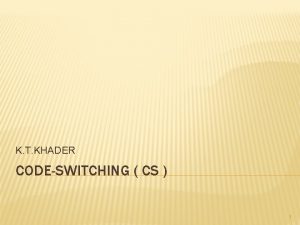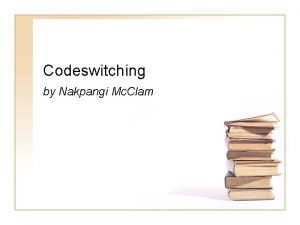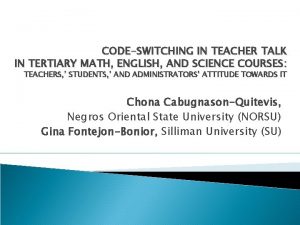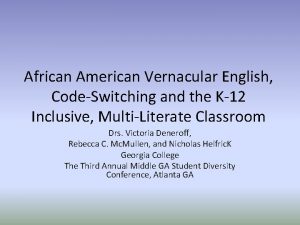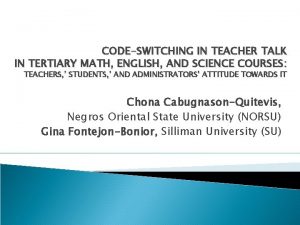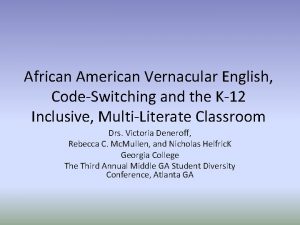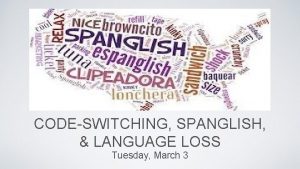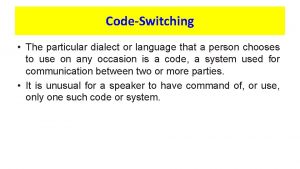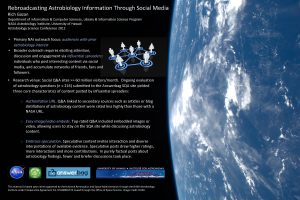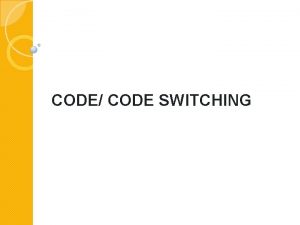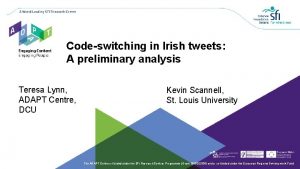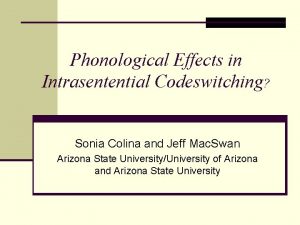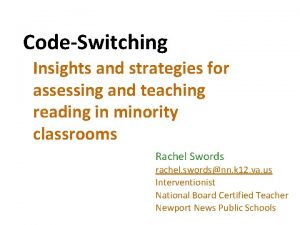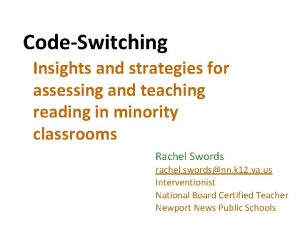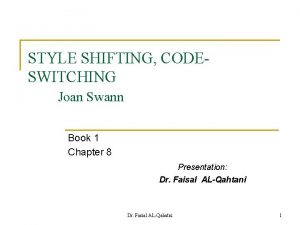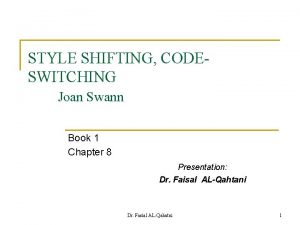The Effectiveness of Codeswitching on Gazan English Language





















![Reasons for code Switching (Youkhana, 2012) &( Shay, 2015) • [1] it provides students Reasons for code Switching (Youkhana, 2012) &( Shay, 2015) • [1] it provides students](https://slidetodoc.com/presentation_image_h2/b8ede3e3aca4d400a36d57608fe585a5/image-22.jpg)
![Resson for CS (Johansson , 2013) [6] to signal the transition between preparing for Resson for CS (Johansson , 2013) [6] to signal the transition between preparing for](https://slidetodoc.com/presentation_image_h2/b8ede3e3aca4d400a36d57608fe585a5/image-23.jpg)


















- Slides: 41

The Effectiveness of Code-switching on Gazan English Language Teachers at UNRWA Preparatory Schools Research paper submitted to : Prof. Walid Amer. Prepared by : Mona Jameel Al Najjar 220160210 2017 -2018

• • • • • Research Outline Abstract Key words Introduction Importance of the Study Theoretical Framework Research Questions What is code switching? Types of Code Switching Code switching vs. Code Mixing Reasons for code switching Functions of codes switching The effectiveness of code switching Students' reactions and perceptions of CS Methodology Results Conclusion and Recommendations Citation

Abstract This paper aims to investigate Code-switching as a widely-spread phenomenon among Gazan English Language teachers. The purpose of the study is to discuss code switching , its types , functions and importance. It also highlights some teachers' reactions and perceptions of it. It is mainly focusing on the effectiveness and seriousness of code-switching as a well- known linguistic phenomenon that affects students' mastering linguistic and communicational competence. Moreover , it pinpoints the motives that lead teachers to code switch in the classrooms.

• This paper considers the qualitative design presented by recordings for a number of teachers as data collection tools. Participants are not previously informed that their speeches are recorded to increase validity and reliability of the results. The unintended recordings took place at preparatory UNRWA schools in Gaza on December 14 th , 2017 in the same conditions and circumstances. • In light of the results and CAT , it is clearly noticed that teachers tend to converge in most of the situations in which they code-switch. Further, it is confirmed that teachers use code switching for many common logical reasons and functions Finally, it was assured that code switching is an effective communicative tool in English language teaching classrooms based on the findings of the recordings and many other previous studies.

Key words Code witching – Code mixing - Accommodation Theory • Introduction • The study of language contact as a phenomenon has increased in the last few years. Different types of language contact phenomenon have been researched such as code-switching, code-mixing, language maintenance and language shifting. The study of code switching is concerned with the relationship between change or stability in habitual language use, on the one hand, and ongoing psychological, social or cultural processes, on the other hand, when populations differing in language are in contact with each other.

• That languages sometimes replace each other, among some speakers, particularly in certain types or domains of language behavior, under some conditions of intergroup contact, has long aroused curiosity and comment. • Code switching can be considered as a natural product of bilinguals’ interaction in two or more languages in multilingual and multicultural communities. It is normal for a speaker who speaks two or more languages fluently to switch or mix between them on justness or frequently while speaking to other people who speak the same languages. This research purpose is to investigate if code-switching is a beneficial language strategy contributing to linguistic and communicative competences.

Importance of the study • The phenomenon of code switching appears in the conversations among Arab bilingual speakers of English where they use a lot of English expressions and loanwords. Different studies have been conducted on code switching , but few have been done on Arabic bilingual speakers of English. As a result, there is a lack of information about the way Arab speakers specially the Gazan teachers of English language who switch between the two languages in daily dialogues or conversations. • Many studies have been conducted on code switching but very few of them discussed it within the Gazan English Language teachers. Thus , this paper will concentrate on the reasons why teachers tend to code switch between English and Arabic in their teaching. It will also investigate Code-switching as a part of foreign language learning; is it positive or negative foreign language learning.

Theoretical Framework • Doubtlessly , code switching is of great concern to sociolinguists because of it effects in the language use in societies. Many people speak and switch or mix their general use of language with their mother tongues. It is a common phenomenon in bilingual or multilingual societies as they understand the different codes they use in different social contexts. Many researchers considers it a demerit of a language though many updated articles discussed the positivity of it on the L 2 societies.

• Code switching is the change of one language to another within the same utterance or in the same oral/ written text. In this paper , the researcher will use the Communication Accommodation Theory (CAT) by Howard Giles as frame work. • In this regard , people tend to either to narrow the social distance with others to be like them or divert to dissociate with them or emphasize distinctiveness. For example , using a slang or a very informal speech with a professor. Thus , speaking helps to shape the identity of the speaker through speech adjustment. Moreover , audience design is directing speech towards others by code choices.

Research questions • 1. What are the motives for teachers' for Gazan teacher's code-switching ? • 2. Is code switching considered an effective communicative tool in English language teaching classrooms?

What is code switching ? • Code switching can be defined as a system used for communication between two or more parties on any occasion , whereas switching means shifting (Wardhaugh & Fuller, 2015). • Code switching (CS) is shifting from one language to another within the same utterance and/or speech event. Approaches to CS are divided into two main categories: socially oriented studies and grammatical structure analyses. Many research studies that have been carried out have offered the existence of constraints in code switching for Bilingual individuals.

What is code switching ? Schendl and Wright (2011) defined code-switching as • the ability to alternate between languages in an unchanged setting, often within the same utterance. In the context of this research, this means English teachers’ and English as a L 2 students’ ability to alternate between English and Arabic in the language classroom. Furthermore, Schendl and Wright (2011) stated that • all speakers have the ability to use language varieties in their language repertoire. This means different things depending on speaker and context.

Previous studies on CS (Mkahal, 2016) Bilinguals incorporate code switching into their speech • when they have insufficient knowledge of one of the languages and try to convey a message more explicitly in their mother tongue. Thus, the functions and purposes of CS are not agreed upon. However , there are many agreements on whether or not codeswitching is beneficial and when it is supposed to be used. On one hand it is argued that the TL is to be preferred as it maximizes students’ exposure to the L 2 , on the other hand other, through classroom observations, teachers’ and students’ code-switching in the language classroom can be considered to be a helpful language.

(Ahmad, 2008) A questionnaire based on 257 participants, he studied how low proficiency learners where influenced by teachers’ use of code-switching in the language classroom. The study suggested that teachers’ code-switching in the language classroom is a valid asset for low proficiency learners and that teachers’ code-switching is connected to learners’ support. However, questionnaires and interviews suggested that if the teacher frequently codeswitch in the classroom this will lead to a risk of students limiting their use of the TL. Additionally, It was emphasized that pupils’ native language should not be ignored; instead schools should respect their pupils’ mother tongue

(Johansson, 2013) Moreover , previous studies view the usage of code- • switching differently. The national curriculums in England also argues that pupils’ L 1 should be avoided and that the TL is the only language recommended to be used in the language classroom. France, on the other hand, recommends that pupils should learn the TL by gradually limit the use of French in the classroom. The Swedish curriculum for secondary school does not • give any direct indications to whether code-switching should be used or not in the language classroom. As a result, individual teachers’ usage of code-switching may differ. Because of the present conflict in the field of code-switching it is relevant to further investigate if

Types of code switching

Code Definition Switching Example 1. Inter- switching outside the sentence or He wanted to leave sentential clause level, for example at sentence because hwa hazeen jedan. switching or clause boundaries. (very sad / )ﺣﺰﻳﻦ ﺟﺪﺍ switching within a sentence or Please , arjook, help me clause. (arjook is "please" in Arabic) switching a tag phrase or Ana already shoftak mn word from language B into zman i. e (I have language A seen you before) 2 Intrasentential switching 3 Tagswitching 4 already

4 - Intra-word switching: switching within a word itself, such as at a morpheme boundary. EX: Iam tamamation. ( tamam in English means fine but the suffix "ation"is English and helps in giving tamam an English status.

Types of Code Switching • According to Haugh & Fuller (2017) code switching can be classified into situational and metaphorical code switching. The former occurs when the language change according to the situation , so it's the situational variety of language use and a matter of choice of the speakers. While the latter refer to the choice of code carries symbolic meanings just as using metaphors. CS is used to measure bilingual ability in such away where intra-sentential switches indicate a great degree of competence in the two grammars involved , whereas inter-sentential switches do not generally require grammatical competence in both languages (shay, 2015).

Code switching vs. code mixing • On one hand , code-switching is thus a term in linguistics referring to the use of more than one language or variety in conversation. As a result , it describes the phenomenon that occurs at the intersentential level of linguistic usage. On the other hand • In China, code-switching occurs very frequently in regions where the spoken variety differs greatly from Standard Mandarin, the lingua franca. Many regions speak three varieties, along with Mandarin. As a former British colony, code-switching in Hong Kong switches between Cantonese and English.

• Code-mixing refers to any admixture of linguistic elements of two or more language systems in the same utterance at various levels: phonological, lexical, grammatical and morphological. The main motivations to switch or mix are: to joke, means of expression, lack of language knowledge, change in members, and to maintain a sense of comfort. There are two distinct fields of approach applied to the study of bilingual language use: the grammatical perspective and the socio-functional perspective
![Reasons for code Switching Youkhana 2012 Shay 2015 1 it provides students Reasons for code Switching (Youkhana, 2012) &( Shay, 2015) • [1] it provides students](https://slidetodoc.com/presentation_image_h2/b8ede3e3aca4d400a36d57608fe585a5/image-22.jpg)
Reasons for code Switching (Youkhana, 2012) &( Shay, 2015) • [1] it provides students with sufficient input in the two languages for them to derive grammatical and lexical information • [2] it enables students with differing relative language proficiencies to focus on learning the concepts being presented during content area instruction • [3] it provides a way of establishing equal prestige for both languages within the classroom setting, and then is likely to encourage a balanced distribution of the two languages • [4] it encourages the kind of language behaviour commonly used among bilinguals who are proficient in both languages • [5] it keeps the students on task and thus contributes to the accumulation of academic learning
![Resson for CS Johansson 2013 6 to signal the transition between preparing for Resson for CS (Johansson , 2013) [6] to signal the transition between preparing for](https://slidetodoc.com/presentation_image_h2/b8ede3e3aca4d400a36d57608fe585a5/image-23.jpg)
Resson for CS (Johansson , 2013) [6] to signal the transition between preparing for a lesson and the start of the lesson [7] to specify a particular addressee [8] to distinguish 'doing a lesson' from talking about the lesson [9] to change footing or make an aside [10] to distinguish questions from a written text from talking about them, {11] to bring out the voices of different characters in a narrative [12] to distinguish classroom management utterances from talks related to the lesson content.

(Azlan &Narasuma , 2013) Provide different justifications for code switching • were stated such as lack of register , mode of the speaker , to emphasize a certain point or as a habitual experience. He also added that it is used for semantic significance. For example to signal the speaker’s attitude, communicative intentions, and emotions to convey linguistic and social information. Moreover , it could be used to show identity with a group , address a different audience or to attract attention. Finally , it's used for pragmatic reasons like to call attention to the context of a conversations

Functions of Code Switching (Shay , 2015) -Affective functions ; to express emotions - to build solidarity and intimate relations with the ss - create a supportive language environment in the classroom. - code switching is effective in repetitive forms for more clarification. - (repetition may leads to students boredom or carelessness in learning as they mastered a certain form in L 1 and ignored it in L 2)

• It’s mentioned that if the teacher would use the TL it is not assured that it would be understood adequately by the students Svendsen (2014). • According to Low (2016) CS has 3 main functions: to construct and transmit academic knowledge, to manage classroom and to improve interpersonal relations. • code-switching is beneficial when it comes to time-saving • Some students prefer English lessons because they consider it to help their language development(Johnasson, 2013) • Skolverket (2000) also stresses every student’s right to pass all subjects in school and that if a student is at risk of failure, the school will give enough support to the student for him/her to pass. One interpretation of this is that teachers should use students’ L 1 as a tool, if this supports pupils with low proficiency in English. Here , it is a necessary to code switch to help students. •

Previous studies on effectiveness of CS • CS enables them with differing relative language proficiencies to focus on learning the concepts being presented during content area instruction. Moreover, it provides a way of establishing equal prestige for both languages within the classroom setting, and then is likely to encourage a balanced distribution of the two languages • ( Nordin et al , 2013). • It was further emphasized by Ahmad (2008) that codeswitching serves as a mean to provide students with opportunities to communicate and enhance their understanding. Besides facilitating classroom instruction, it also promotes effective transfer of information and skills which lead to a better understanding of learning among

• Code switching is a strong and fruitful strategy of teaching English to the learners, but it has its own limited bounds. It should in no way, be estimated as a method. Hence it is inferred that teacher’s code switching is closely related with learners’ affective support and their success in performing various classroom assignments (Malik, 2014). • Some researchers claim that code-switching can be an advantage in L 2 learning while others think that codeswitching only has disadvantages. Some scientists think that code-switch make a mess out of the conversation and cannot speak the language properly. However, there are researchers who see code-switching in a positive light (Liebscher &Dailey , 2005) •

• Sert (2005) suggests that code-switching can have a positive effect. When we code-switch , we build a bridge from the known, our native language to the unknown, target language. He also claims that this may have a vital and positive effect on foreign language learning. Further , he thinks that codeswitching in foreign language classrooms is useful as he considers it a tool for creating linguistic solidarity, especially between individuals who share the same ethno-cultural identity. • Teachers also believe that the use of L 1 has a positive influence on the learners’ L 2 intake. It seems that L 1 can be recommended as an academic tool in the low proficiency ESL classroom. It not only makes the input more comprehensible but also minimizes communication breakdowns while making the classroom atmosphere less threatening. It was also noticed that CS is commonly used in low levels rather that high proficiency levels (Makulloluwa , 2013).

Teachers and students' reactions and perceptions of Code Switching • It is worth mentioning that the frequent use of code switching is reflected on the students' use of their first language. As a result , some researchers claims that CS should be reduced to effectively and increasingly use and practice English language in the classroom. • According to Nordin et. al. (2013) majority of the learners perceive teachers’ code-switching as a must in their ESL classroom. A majority of the learners agree that teachers’ codeswitching help learners learn English better. Students agree that they would best benefit from various occasions of teachers’ code-switching in an ESL classroom setting.

• Moreover, some scientists think that teachers should encourage code-switching instead of forbidding it in foreign language classrooms. They also suggest that teachers should see code-switching as an advantage and that the use of L 1 (first language) is good and meaningful in order to encourage L 2 acquisition. • However , there is an argument that the use of the native language in the L 2 classroom must be avoided. • Simon (2001) claims that code-switching in foreign language classrooms has been forbidden for a long period of time. It was at the end of 19 th century that the use of native language in foreign language classrooms was seen as taboo. The goal was to let pupils be surrounded by only the target language so that they would be as much involved with the target language as possible

Methodology • The research design is qualitative and the data collection tool is indirect recordings. The participants are 30 teachers of English language at different preparatory UNRWA schools in Gaza. They aren’t told that their classes are recorded to preserve much authenticity and validity. The recordings took place in the classes for the same topic and length for each recording is 45 minutes. The recordings were transcribed to analyze them. • Sample Transcription • T: Good morning girls. What do you think of the weather today ? I think it is fascinating ? ﺻﺢ • S: ﺍﻩ. It's very nice! • T: Ok. Today we are going to discuss a very important topic which is "reflexive pronouns " • S: reflexive pronouns ? ﺍﻷﻔﻌﺎﻝ ﺍﻟﻤﺎﺿﻴﺔ • T: No , it is ﺍﻟﻀﻤﺎﺋﺮ ﺍﻟﻤﻨﻌﻜﺴﺔ. Please look at me and pay attention ﺍﻧﺘﺒﻬﻮﺍ ﻋﻠﻴﺎ ﻳﺎﺑﻨﺎﺕ

• Imagine that this is a mirror , you know the meaning of mirror ? • S: Yes teacher ﻣﺮﺃﺔ • T: Good. So, I can see myself ﻧﻔﺴﻲ in the mirror. Come here Shahed , we can see ourselves ﺃﻨﻔﺴﻨﺎ. Shahed can see herself ﻧﻔﺴﻬﺎ. Set down Shahed ﺷﻄﻮﺭﺓ. • T: OK. You can see yourself ﻧﻔﺴﻚ. He can see himself ﻧﻔﺴﻪ. They can see themselves ﺃﻨﻔﺴﻬﻢ • Now! You are going to practice using these reflexive pronouns in pairs. ﺛﻨﺎﺋﻲ • S: ﻣﺲ ﻧﻜﻮﻥ ﺟﻤﻞ ﻳﻌﻨﻲ ﻭﻧﺴﺘﺨﺪﻡ ﻓﻴﻬﻢ ﺍﻟﻀﻤﺎﺋﺮ ﺍﻟﻤﻨﻌﻜﺴﺔ ؟ • T: yes ! ﺑﺎﻟﺰﺑﻂ • T: Ok. Who is ready to come say them loudly ? yes come here ﻳﺎ ola • S: ﺃﺒﺪﺍ ﺃﻨﺎ ﻭﻻ ﻫﻲ ؟ • T: Yes you first ﺑﻌﺪﻳﻦ ﻫﻲ • S: I can study with myself. She can taught herself. We can enjoy ourselves. • T. Ok great. What do you mean by " I can study with myself" ? ﺷﻮ ﺑﺘﻘﺼﺪﻱ ؟ • S: ﺍﻧﻮ ﺃﻨﺎ ﺑﺪﺭﺱ ﻣﻊ ﻧﻔﺴﻲ with myself • T: Aha , but you should say : I can study by myself ﺃﺴﺘﻄﻴﻊ ﺍﻥ ﺃﺪﺭﺱ ﺑﻨﻔﺴﻲ OK. Thanks • S: Can we write ﺍﻟﺠﻤﻞ ﻋﺎﻟﺪﻓﺘﺮ • T: Yes but after you do ex 1 in the book in groups. Go ahead ! Read silently then answer them in pairs. • S: We have finished teacher. • T: Ok. Check your answers in pairs

Discussion of results It is clearly noticed that CS is excessively used for different • purposes like: [1] explaining grammar, • [2] giving instructions, • [3] monitoring/assisting the students • [4] when correcting activities and interestingly to attract • learners’ attention. In most cases, the teachers needed to code switch in order to • clarify words, expressions, structures and rules of utterances. Thus from the above functions, code-switching does play an important role in ESL classrooms as it helps learners to better understand the target language. This proves the impact on the students language development in the classroom as mentioned in many studies (Nordin et al , 2014).

Discussion of results - Generally, the range amount of code switching by the teachers depends on the teachers beliefs , some teachers use it frequently , others regularly and some others barely use it. It also depends on the content , some teachers use it when focusing on the content while others most frequently use it when explaining grammatical rules. All in all , the main reason to why it differs depend on teachers’ personal opinion and pedagogical beliefs about when code switching is beneficial for example in classroom management or language development (Svendsen , 2014). - Scholars have described the effects of using multiple language • varieties has on class, ethnicity, gender, or other identity positions. Scholars in interactional linguistics and conversation analysis also study code-switching as a means of structuring talk in interaction.

Discussion of results It is worth mentioning that CS is very beneficial for both teachers and students for many reasons as used to : • 1. Signal the transition between preparing for a lesson and the start of the lesson. • 2. Specify a particular addressee and distinguish doing a lesson from talking a lesson. • 3. Distinguish questions from a written text from talking about them. • 4. Bring out the voices of different characters in a narrative. • 5. Differentiate management utterances from talks related to the lesson content.

Conclusion • Generally, code-switching can be used as a language strategy in the classroom, as it may contribute to conversation and keep conversations to abate. However, in the real world it is harder to use code-switching as a language strategy when speaking to a person who only knows English. Nevertheless, it can support language development if used in the right way. Therefore, it is important for language teachers to consider when it is appropriate to use pupils’ L 1 in regards to oral language development. • Furthermore, previous studies revealed that low proficiency students’ benefit mostly from code- switching used as tool, both when used by the teacher, as well as by the student themselves. High proficiency pupils, on the other hand, seem prefer an English only classroom. This may result in teachers having to use pupils’ L 1 in case there are low proficiency learners in risk of failing the course. However, teachers should try to encourage students to rephrase in the TL, as a way to motivate them to use English, if they code-switch because they are not being understood.

Conclusion - Code-switching can be beneficial for pupils’ oral language • learning when it comes to understanding grammatical rules better. Furthermore, it is also indicated that it can be useful to explain instructions in pupils’ L 1, when instructions in the TL are too complex. Additionally, it seems to be beneficial for pupils to use the L 1 in order to understand linguistic differences in both languages and in that way avoid language errors caused by the L 1. -To sum up , code switching is useful when it comes to oral • instructions connected to grammar learning. It can help pupils to comprehend grammar rules better. By using pupils’ L 1 to explain L 2 grammar concepts pupils may be more aware of linguistic differences and as a result it can reduce L 1 interference (Svendsen , 2014).

Recommendations In the light of the investigations about the effectiveness of code switching strategy, it is concluded that it assists positively in inspiring the learners to continue learning English. Thus, teachers should provide a care free class room atmosphere to improve the students’ ability of comprehension. Nevertheless, the teachers should be very careful and cautious while code switching. Moreover, it should not be used excessively as it may turn the pace of learning very slow. Besides, code switching should be used only for those learners who are weak in language acquisition and not for proficient students or activities that need fluency like role-play and debates.

Recommendations In this regard , Gazan teachers should not over use • code switching in their English classes , instead they should in consideration some variables like the topic , students level , degree of difficulty and clarity. At the same time , they have to be convincing and moderate to focus on the general purpose of teaching English as a second language. Finally , a good command of English competence and performance cannot be fulfilled away of codeswitching in teaching English as L 2.

Thanks
 Engineering graphics basics
Engineering graphics basics A level english language language change
A level english language language change Hát kết hợp bộ gõ cơ thể
Hát kết hợp bộ gõ cơ thể Slidetodoc
Slidetodoc Bổ thể
Bổ thể Tỉ lệ cơ thể trẻ em
Tỉ lệ cơ thể trẻ em Chó sói
Chó sói Tư thế worm breton
Tư thế worm breton Chúa sống lại
Chúa sống lại Môn thể thao bắt đầu bằng chữ đua
Môn thể thao bắt đầu bằng chữ đua Thế nào là hệ số cao nhất
Thế nào là hệ số cao nhất Các châu lục và đại dương trên thế giới
Các châu lục và đại dương trên thế giới Cong thức tính động năng
Cong thức tính động năng Trời xanh đây là của chúng ta thể thơ
Trời xanh đây là của chúng ta thể thơ Mật thư anh em như thể tay chân
Mật thư anh em như thể tay chân Phép trừ bù
Phép trừ bù độ dài liên kết
độ dài liên kết Các châu lục và đại dương trên thế giới
Các châu lục và đại dương trên thế giới Thể thơ truyền thống
Thể thơ truyền thống Quá trình desamine hóa có thể tạo ra
Quá trình desamine hóa có thể tạo ra Một số thể thơ truyền thống
Một số thể thơ truyền thống Cái miệng bé xinh thế chỉ nói điều hay thôi
Cái miệng bé xinh thế chỉ nói điều hay thôi Vẽ hình chiếu vuông góc của vật thể sau
Vẽ hình chiếu vuông góc của vật thể sau Thế nào là sự mỏi cơ
Thế nào là sự mỏi cơ đặc điểm cơ thể của người tối cổ
đặc điểm cơ thể của người tối cổ V cc
V cc Vẽ hình chiếu đứng bằng cạnh của vật thể
Vẽ hình chiếu đứng bằng cạnh của vật thể Fecboak
Fecboak Thẻ vin
Thẻ vin đại từ thay thế
đại từ thay thế điện thế nghỉ
điện thế nghỉ Tư thế ngồi viết
Tư thế ngồi viết Diễn thế sinh thái là
Diễn thế sinh thái là Các loại đột biến cấu trúc nhiễm sắc thể
Các loại đột biến cấu trúc nhiễm sắc thể Bảng số nguyên tố lớn hơn 1000
Bảng số nguyên tố lớn hơn 1000 Tư thế ngồi viết
Tư thế ngồi viết Lời thề hippocrates
Lời thề hippocrates Thiếu nhi thế giới liên hoan
Thiếu nhi thế giới liên hoan ưu thế lai là gì
ưu thế lai là gì Hổ đẻ mỗi lứa mấy con
Hổ đẻ mỗi lứa mấy con Sự nuôi và dạy con của hươu
Sự nuôi và dạy con của hươu Hệ hô hấp
Hệ hô hấp










































